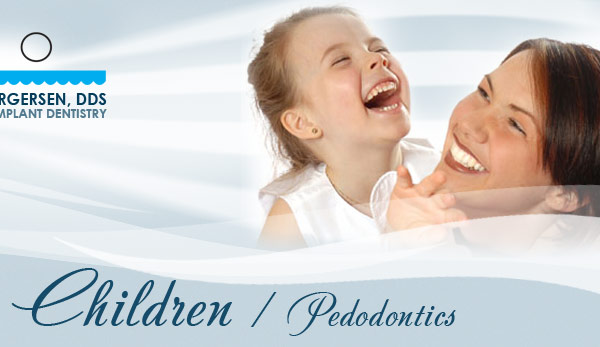
Quality Children´s Dentistry in Camarillo & Simi Valley
Pediatric dentistry is a branch of medical dentistry that deal with the diagnosis and treatment of infants, children and adolescents, including those patients with special care needs.
When to take your child to Dr. Trent and Gina Torgersen for the first time?
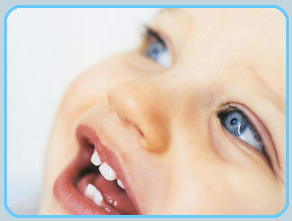
We recommend that you arrange an appointment between the first and second birthdays, so that we can examine for a good oral hygiene, check for decay, and any developmental or congenital disabilities.
The first dental visit is normally quick and easy. This visit provides your child the opportunity to meet Dr. Trent and Gina Torgersen in a non-frightening and friendly manner. During this visit, the parent holds the child on his or her knee while Dr. Trent and Gina Torgersen sit in front of the parent knee to knee. While the child will not yet have all of his or her baby teeth in place by this age, a visual inspection allows Dr. Trent and Gina Torgersen to evaluate for the formation of early childhood decay (nursing bottle caries) and to advise the parents on any noticeable problems that may emerge. Dr. Trent and Gina Torgersen or hygienists may clean any teeth and consider the need for fluoride. They will also educate parents about oral health care basics for children and explain dental development issues and answer any questions and concerns. It also establishes a record for the child and parents.
How often do children need to visit Dr. Trent and Gina Torgersen?
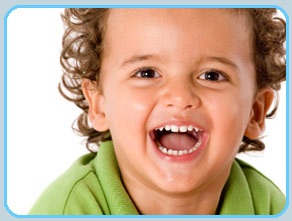
Children should see a dentist every 6 months. We like to catch anything when it is little and by seeing the child every 6 months gives us the best possibility to keep an eye out for any signs of developing decay. Furthermore, since the teeth start to come and go, we want to have the history of dental development for each patient.
At what age should your baby's first teeth erupt? ("erupt" means to "appear in the mouth".)
The baby teeth begin to erupt at about age 6 months and continue until about age 24 months at which time all 20 of the baby teeth should be in place. In general, the teeth erupt from the front to the back, and the lowers come in about 2 to 6 months before the corresponding top teeth. If your child is late, don't worry. Sometimes, they can be a year behind the schedule. If your child is missing one or more baby teeth, it does NOT necessarily mean that she will be missing the corresponding adult teeth. If some of the baby teeth are discolored or misshapen, it does NOT usually indicate that there will be a problem with the adult teeth.
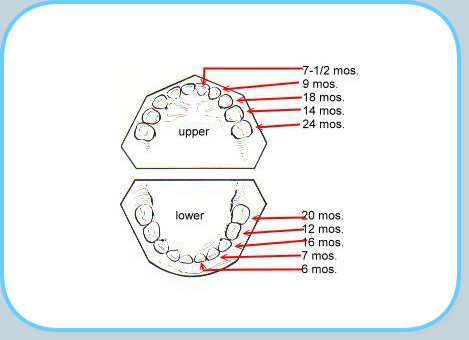
At what age should your child's adult teeth erupt?
You should start seeing the first adult teeth of your child even before they lose their first baby teeth at around age 6. They are the first adult molars and they erupt behind the current baby teeth. They are yellow in the diagram as shown above. Almost at the same time the lower baby central incisors will loosen and fall out to permit the adult central incisors (blue) to erupt. All baby teeth should be gone around the age of 12. Adult teeth that are developing below them continue to erupt to the age of 17 or 18, when the wisdom teeth (white) are supposed to eventually erupt. We say "supposed to" because they are often impacted and should be extracted. This eruption schedule is not set in stone. Some children "just take their time" and may be a year late in their schedule of eruption. Some may even be a year earlier.
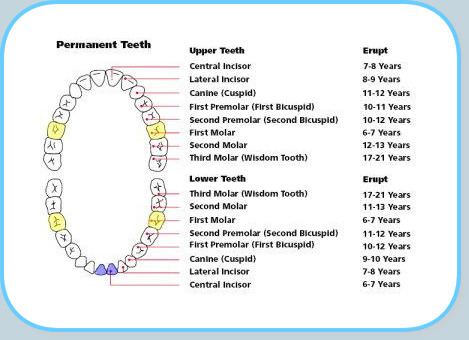
Why is it important to brush your child’s teeth?
Children can build up plaque just like adults and should be removed every day to avoid tooth decay. Use a soft-bristled toothbrush to fit the mouth of the child at least once a day to start with at a very young age and at least twice a day when most primary teeth have erupted.
Here are some Frequently Asked Questions
Children can build up plaque just like adults and should be removed every day to avoid tooth decay. Use a soft-bristled toothbrush to fit the mouth of the child at least once a day to start with at a very young age and at least twice a day when most primary teeth have erupted.
Baby teeth are very important because they perform many functions the same as the adult teeth such as breaking and chewing food and helping the child to speak correctly. They also hold the place for permanent teeth. If baby teeth are lost too early, a device called a space maintainer is recommended to prevent the remaining teeth from moving into the space of missing teeth.
In some cases, a baby tooth may remain in place even though the adult tooth is erupting beside it. In this case, the baby tooth MUST come out one way or another or it will interfere with the positioning of the adult tooth. If the child cannot or will not remove it herself by shaking it back and forth, then take her in to see us for an extraction.
There is not much difference between the two habits and they only become a problem if the baby teeth start to get misaligned, or if the practice continues after the adult teeth have erupted.
Decay is not only caused by candy or chocolates. Most of the foods or liquids other than water that is not removed from the tooth surface can cause decay. Infants and children are at the mercy of their parents. If a toddler is continuously given a bottle with almost anything other than water before going to sleep, they will probably develop baby bottle tooth decay, which is the decay of the front teeth. Do not give a bottle with anything other than water and make a habit of brushing your child's teeth regularly.
Fluoride toothpaste should not be used for children younger than 2 years old. After this time, parents should be responsible for dispensing the toothpaste. The amount of the toothpaste to be used each time should not exceed the size of a pea. Make sure that children spit out the toothpaste rather than swallowing it. It is not harmful if they swallowed it once or twice but do not allow it to become a habit.
At times parents ask us if it is normal to hear their child grind his or her teeth at night. The sound can be so intense that it can be quite frustrating, being audible in the neighboring rooms even if the doors are closed! The answer is that it is natural for children under the age of about 13 to grind their teeth at night. It appears to have two purposes.
Grinding puts pressure on the roots of the baby teeth over the forming adult teeth, which stimulates resorption (natural destruction) of the roots of the baby teeth. Resorption is ultimately responsible for the shedding of the baby teeth when the adult teeth are ready to erupt.
Grinding also guides the adult teeth to erupt into the correct positions in the dental arches.
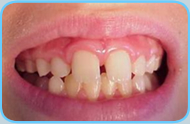
Many times, children come in with congenital abnormalities (ones that they are born with) or developmental problems (ones that are caused by other factors such as thumb sucking or other habits, and some like crowded teeth that result from genetic factors but are not apparent at birth). Many of these cases are not noticeable to the parents, and require a dental checkup to identify them. If they remain untreated, these abnormalities can cause many functional and esthetic problems for the child in the coming years. It is important that all children be examined for orthodontic defects by about the age of 7 when most typical skeletal defects can most easily be treated.
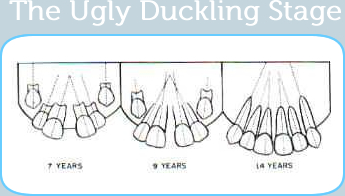
This stage of development needs special explanation because so many parents mistakenly identify it as an orthodontic problem. This is called the "ugly duckling" stage when there is a space between the top central incisors. This is normal between ages 7 to 12 years of age, and normally is not connected with a permanent space between the teeth. The condition is well diagramed above.
Besides size, there IS a difference in both anatomy and physiology between baby teeth and adult teeth. The baby tooth has a bigger nerve relative to the size of the rest of the tooth than the adult tooth. That means that decay in any part of a baby tooth has less range to travel to get to the nerve than in an adult tooth. When we treat decay in either type of tooth, we always make the cavity preparation larger than the original dimensions of the decay to make sure the filling is mechanically stable, which means that we are more likely to strike the nerve in a baby tooth when repairing it.
This does not imply that it will cause pain to the child because he or she has already been anesthetized. However, the difference in physiology between baby teeth and adult teeth means that special preventative measures must be taken if the nerve in a baby tooth is impacted in the process of eliminating the decay.
There are no absolute rules as to when to begin the dental X-rays. Some children who may be at higher chances for dental problems (such as, those expose to baby bottle tooth decay or those with cleft lip/palate) should take X-rays earlier than others. Normally, most children will have had X-rays taken by the age of 5 or 6. As children begin to get their adult teeth around the age of 6, X-rays play a very valuable role in helping Dr. Trent and Gina Torgersen. X-rays allow Dr. Trent and Gina Torgersen to distinguish if all of the adult teeth are growing in the jaw, to look for bite problems and to determine if teeth are uninfected and healthy.
Call for your appointment today!


